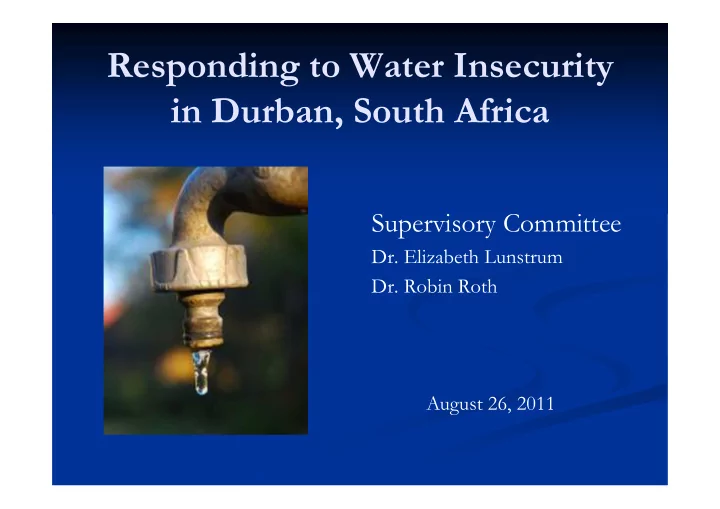

Responding to Water Insecurity in Durban, South Africa Supervisory Committee Dr. Elizabeth Lunstrum Dr. Robin Roth August 26, 2011
Context � International praise vs. on-the-ground reality � Implications � Constitution � Gender � Wasted water � Public health
Situating the Field
Situating the Field
South Durban � Spanning the racial and socio-economic spectrum � Dumping ground for pollutant industries � Strong tradition of social movements
Major Research Question � How do Durban residents respond to water insecurity (e.g. lack of accessibility, availability, or quality) and how does this shape water security in Durban?
Literature Review � Environmental Justice Bond, 2010; Bond & Dugard, 2008; Bond & Ruiters, 2001; Debbané & Keil, 2004; Glazewski, 2002; Harvey, 1996; Ruiters, 2002; Schlosberg, 2004; 2007 � Social Movements Barchiesi, 2006; Desai, 2002; Peek, 2002; Robins, 2008; Virno, 2004; 2008; Zuern, 2011
Sub-Questions What aspect(s) of water insecurity (e.g. � accessibility, availability, or quality) impact Durban residents the most? How does this differ within and amongst residents of Wentworth, uMlazi, and various flats in town?
Sub-Questions In what ways do resident responses differ from � and inform one another, if at all? Is this related to differences in identity? Do residents organize themselves in sync with Virno’s concept of the multitude?
Sub-Questions Do residents feel that local NGOs government � are representative of their interests? How have the relationships between residents, NGOs, and government changed since 1994?
Sub-Questions Do residents address the causes of and � solutions to, rather than simply the existence of, water insecurity? How does this tie in with Schlosberg’s four pillars of environmental justice: distributive justice; recognition; participation; and capabilities?
Sub-Questions What role do local residents play in influencing � water security and what, if anything, are they doing to transform this role? What changes to water security do residents � anticipate facing in the future, and why? What, if anything, are they doing in response to this?
Research Design & Methodology � Instrumental case study � Semi-structured interviews � Document analysis
Limitations � Outsider status � Language � Inexperience � Time � Money
Thank you
Recommend
More recommend